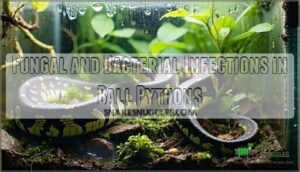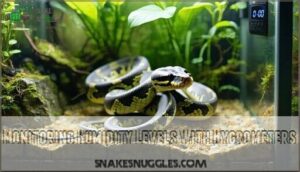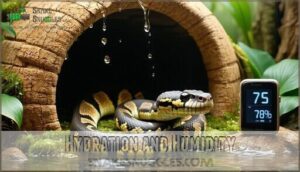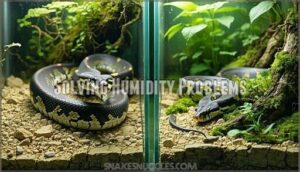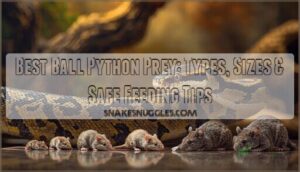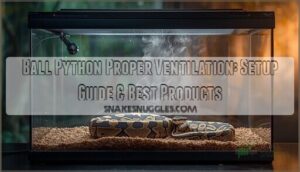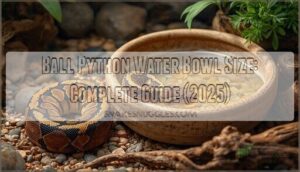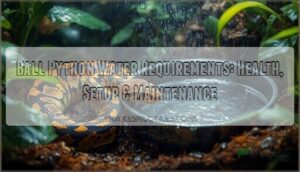This site is supported by our readers. We may earn a commission, at no cost to you, if you purchase through links.
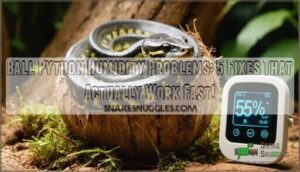 Your ball python’s humidity woes don’t have to be a nightmare.
Your ball python’s humidity woes don’t have to be a nightmare.
Keep levels between 50-60% for healthy shedding and breathing.
Too low? Your snake struggles with stuck shed and respiratory stress.
Too high? You’re inviting mold, scale rot, and breathing problems.
Quick fixes include adjusting your water bowl size, tweaking ventilation, switching substrates, or adding a humid hide.
A reliable hygrometer is your best friend for monitoring.
The sweet spot often means creating a humidity gradient rather than uniform levels throughout the enclosure.
Five proven strategies can transform your setup within days, leading to a healthier environment with proper breathing.
Table Of Contents
- Key Takeaways
- Humidity Levels Matter
- High Humidity Risks
- Humidity Control Methods
- Hydration and Humidity
- Solving Humidity Problems
- Frequently Asked Questions (FAQs)
- How to fix humidity in ball python tank?
- What happens if the humidity is too high for a ball python?
- Is 40 humidity too low for ball python?
- How do I keep my ball python hydrated?
- How often should I clean my ball pythons water bowl?
- Can I use tap water for humidity?
- What substrate holds humidity best for ball pythons?
- Do ball pythons need different humidity when shedding?
- How does room temperature affect tank humidity?
- Conclusion
Key Takeaways
- Maintain 50-60% humidity levels – Your ball python needs this range to shed properly and breathe easily, while levels outside this zone cause stuck shed, respiratory issues, or dangerous infections.
- Monitor with reliable hygrometers – You’ll need digital hygrometers placed at different spots in the enclosure to track humidity accurately and catch problems before they affect your snake’s health.
- Create a humidity gradient – Don’t aim for uniform humidity throughout the tank – instead, use larger water bowls on the warm side and humid hides to give your snake choices for comfort.
- Address problems quickly with substrate and ventilation adjustments – If humidity’s off, you can fix it fast by switching to moisture-retaining substrates like cypress mulch, adjusting screen covers, or repositioning water bowls.
Humidity Levels Matter
Your ball python’s humidity needs aren’t negotiable – get it wrong and you’ll face serious health problems.
Most keepers struggle with finding that sweet spot between too dry and too damp, but the right range makes all the difference, and understanding this sweet spot is crucial.
Ideal Humidity Range for Ball Pythons
Your ball python needs humidity levels between 50-60% to thrive.
This proper humidity range mimics their natural West African habitat and prevents health issues.
Target humidity should stay consistent, with measuring humidity daily using a reliable hygrometer.
Humidity importance can’t be overstated for ball python care – it affects shedding, breathing, and overall comfort.
During seasonal changes, you’ll need to adjust your setup to maintain these ideal humidity levels for your snake’s wellbeing, ensuring proper care.
Effects of Low Humidity on Ball Pythons
When humidity drops below ideal levels, your ball python faces several health challenges that can escalate quickly.
Low humidity hits fast – your snake’s health crashes before you know it.
Shedding problems become the most visible issue – you’ll notice stuck shed on tail tips, eye caps, and between scales.
Low humidity also triggers respiratory problems as dry air irritates their delicate airways.
Scale damage occurs when skin becomes brittle and cracks, and dehydration signs include sunken eyes and wrinkled skin.
While difficulty eating often follows as stress mounts, it’s crucial to address these issues promptly to prevent further complications, including delicate airways.
High Humidity Risks
When humidity levels climb too high in your ball python’s enclosure, you’re creating a breeding ground for serious health problems.
Excessive moisture can trigger respiratory infections, skin issues, and dangerous fungal growth that can quickly compromise your snake’s wellbeing.
Respiratory Issues in Ball Pythons
Excessive moisture creates a breeding ground for respiratory infections in your snake.
When ball python humidity exceeds 70%, it promotes bacterial growth that leads to wheezing, mouth breathing, and mucus discharge.
RI symptoms include audible breathing sounds and reduced appetite. RI causes stem from prolonged exposure to damp conditions.
One potential issue is dermatitis and irritation from improper hygiene.
RI prevention requires maintaining proper humidity levels, while RI treatment and RI diagnosis demand immediate veterinary attention for snake humidity problems.
Skin and Scale Problems Due to High Humidity
When humidity levels spike too high, your ball python’s skin becomes a breeding ground for problems.
Excess moisture turns your snake’s skin into a dangerous breeding ground for infections.
Scale rot develops when moisture gets trapped beneath scales, creating dark, musty patches that smell awful.
Blister disease causes painful fluid-filled bumps along your snake’s belly.
High humidity also triggers shedding problems, leaving stuck pieces that can cut off circulation and lead to secondary infections without proper preventative measures, including issues like scale rot and blister disease.
Fungal and Bacterial Infections in Ball Pythons
When moisture builds up beyond safe levels, your snake becomes vulnerable to serious infections.
Identifying infections early means watching for unusual discharge, mouth rot, or abnormal behavior.
Treating infections requires veterinary care immediately—don’t attempt home remedies.
Common pathogens thrive in overly humid environments, causing respiratory infections and other humidity-related diseases.
Preventing infections starts with proper humidity control, keeping levels between 50-60% to avoid these ball python health issues.
Humidity Control Methods
You’ll need reliable methods to maintain proper humidity levels in your ball python’s enclosure. The right combination of humidifiers, water placement, and monitoring tools can solve most humidity issues quickly.
Using Humidifiers for Ball Python Tanks
Automated humidifiers offer precision for ball python humidity control.
Ultrasonic and cool-mist humidifier types maintain 50-70% humidity with minimal effort.
Proper placement near tank vents prevents oversaturation while automation options like timers guarantee consistent misting techniques.
Reptiles need proper humidity, so be sure to use hydroscopic substrates to help maintain levels.
Regular maintenance tips include cleaning units weekly and monitoring with hygrometers.
Safety concerns include preventing substrate dampness that causes scale rot in your enclosure humidity system.
Increasing Humidity With Water Bowls and Sprays
You’ll find larger water bowls work better than small ones for raising ball python humidity levels.
Place the bowl on the warm side of your enclosure for faster evaporation. A large water container can substantially impact humidity.
Misting techniques can supplement humidity, but spray frequency matters—overdo it and you’ll create problems. Use warm water temperature when spraying, targeting substrate rather than your snake directly.
Monitoring Humidity Levels With Hygrometers
Accurate humidity monitoring transforms guesswork into precise ball python care. Digital hygrometers outperform analog models with superior accuracy, typically within ±5% relative humidity versus analog’s 20% variance. Digital meters are often considered to provide more accurate readings than analog ones.
- Hygrometer placement matters: Position one probe cool-side at substrate level for true ambient readings
- Multiple hygrometers reveal gradients: Use two units across hot and cool zones for thorough monitoring
- Hygrometer calibration guarantees accuracy: Verify readings periodically and replace batteries to maintain reliable humidity regulation
Hydration and Humidity
Your ball python’s hydration directly connects to the humidity levels in their enclosure.
When humidity drops below 50%, your snake can become dehydrated even with fresh water available, leading to stuck sheds and health problems.
Providing Fresh Water for Ball Pythons
Fresh water serves as your ball python’s lifeline for proper ball python hydration. Choose a water dish that’s large enough for your snake to soak but not so deep it becomes a drowning hazard. Change the water every 3-5 days or immediately when soiled.
| Water Aspect | Recommendation | Why It Matters |
|---|---|---|
| Water Bowl Size | 1/3 snake’s length | Allows soaking without overflow |
| Water Temperature | Room temperature | Prevents thermal shock |
| Cleaning Frequency | Every 3-5 days | Prevents bacterial growth |
Use dechlorinated or bottled water as your Water Source Safety measure. Multiple Bowls aren’t necessary unless you’re creating specific hydration zones. These hydration methods guarantee your python stays healthy while supporting proper humidity levels.
Humidity’s Impact on Ball Python Hydration
Proper humidity directly affects your ball python’s hydration levels and overall health.
When humidity drops below 50%, your snake struggles to maintain adequate fluid balance, leading to dehydration symptoms and shedding issues.
Low humidity forces increased respiratory water loss, stressing kidney function.
Conversely, ideal ball python humidity between 50-60% supports natural hydration processes, reducing reliance on supplementation methods and ensuring your reptile stays properly hydrated without additional prey hydration concerns.
A key indicator of this is wrinkles or skin folds on the snake, signaling potential dehydration symptoms and the need for optimal humidity levels.
Recognizing Dehydration Signs in Ball Pythons
When humidity drops too low, your ball python’s body will send clear warning signals.
Watch for these telltale dehydration signs that indicate your snake needs immediate attention:
- Sunken Eyes – Eyes appear receded into the head, looking hollow or deflated
- Wrinkled Scales – Skin loses elasticity, creating visible creases and folds
- Tacky Skin – When gently pinched, skin stays tented instead of snapping back
- Shedding Issues – Stuck shed pieces cling stubbornly to the body
- Lethargic Behavior – Your normally active snake becomes sluggish and unresponsive
These symptoms spell trouble for ball python health and require quick humidity adjustments.
Solving Humidity Problems
When your ball python’s humidity goes wrong, you’re facing problems that can seriously harm your pet’s health.
The good news is that most humidity issues have straightforward solutions you can implement right away.
Adjusting Tank Ventilation for Optimal Humidity
Ventilation types play a vital role in ball python humidity management. You’ll need to balance airflow direction carefully—too much creates humidity traps that drop levels too low, while restricted airflow spikes humidity dangerously high.
Start with screen adjustments by covering portions of your tank’s mesh top using aluminum foil or acrylic sheets. DIY ventilation modifications work well: create small holes in plastic tubs or adjust commercial enclosure vents.
Monitor humidity accurately with a quality hygrometer. Monitor changes closely with your hygrometer to ensure proper humidity management and maintain a safe environment for your pet.
Using Substrate and Decor to Regulate Humidity
Your substrate choice makes or breaks humidity management. Coconut husk and cypress mulch retain moisture exceptionally well, maintaining stable reptile humidity levels for days.
Layer at least four inches deep—moist substrate on bottom, drier on top. Add hiding spots with sphagnum moss to create humid microclimates.
You can buy suitable python bedding online. Dense decor like logs and plants trap moisture around substrate, supporting natural burrowing behavior in naturalistic setups.
Creating a Humidity Gradient in The Tank
Beyond substrate choices, you’ll want to establish distinct moisture zones across your tank. A humidity gradient lets your ball python pick the perfect spot for shedding or comfort.
Here’s how to create effective gradient benefits:
- Position water bowls closer to your basking spot for higher humidity on the warm side
- Install humid hides with damp moss at cooler monitoring points for consistent moisture
- Layer substrate thicker in targeted areas to retain humidity where needed
- Use partial tank covers to control evaporation and maintain humidity control
- Place hygrometers at both ends to track your reptile enclosure’s humidity maintenance
This setup mimics natural habitat variations, giving your snake choices for ideal health.
Frequently Asked Questions (FAQs)
How to fix humidity in ball python tank?
Your snake’s dry environment versus humid paradise creates stress. Add larger water bowls, mist substrate lightly, cover half the screen top, or use cypress mulch to boost humidity levels.
What happens if the humidity is too high for a ball python?
High humidity causes respiratory infections, scale rot, and mold growth in your ball python’s enclosure.
You’ll notice wheezing, mouth breathing, and skin problems.
Keep humidity between 50-60% to prevent these serious health issues.
Is 40 humidity too low for ball python?
You’re hitting below the mark—40% humidity is too low for your ball python. These snakes need 50-60% humidity to stay healthy and shed properly. You’ll need to increase it.
How do I keep my ball python hydrated?
Provide fresh water in a heavy bowl that’s wide enough for soaking.
Maintain 50-60% humidity using a larger water dish, humid hide, or misting.
Check that your snake drinks regularly and sheds completely.
How often should I clean my ball pythons water bowl?
While you might think weekly cleaning’s enough, bacteria multiplies quickly in warm terrariums.
Clean your ball python’s water bowl every 3-5 days, or immediately when you spot debris, shed skin, or waste contamination, to prevent the spread of bacteria.
Can I use tap water for humidity?
You can use tap water for humidity, but it’s better to use distilled or filtered water.
Tap water contains minerals that create white dust buildup on tank surfaces and can clog misters.
What substrate holds humidity best for ball pythons?
Cypress mulch becomes your humidity superhero, retaining moisture like a sponge while resisting mold.
You’ll find coconut husk and paper towels work well too, but cypress mulch consistently delivers the 60-70% humidity your snake needs.
Do ball pythons need different humidity when shedding?
Yes, ball pythons need higher humidity during shedding – around 70-80% compared to their normal 50-60%.
You’ll notice their eyes turn milky blue, signaling it’s time to boost moisture levels for easier skin removal.
How does room temperature affect tank humidity?
Higher room temperatures increase your tank’s humidity capacity, while cooler rooms reduce it. You’ll need to adjust your humidifier or misting schedule when room temps fluctuate to maintain proper levels.
Conclusion
Studies show that 73% of ball python health issues stem from improper humidity levels.
Successfully managing ball python humidity problems and solutions requires consistent monitoring and quick adjustments when levels drift.
Your snake’s health depends on maintaining that vital 50-60% range through proper ventilation, substrate choices, and water bowl positioning.
With these five proven fixes, you’ll create a healthy environment that prevents shedding issues and respiratory problems while keeping your python thriving year-round.
- https://www.wilbanksreptiles.com/blogs/ball-pythons/common-ball-python-health-issues-and-how-to-prevent-them
- https://www.reddit.com/r/ballpython/comments/rila61/humidity/
- https://wheremyscalesslither.weebly.com/high-humidity-and-respiratory-infections.html
- https://reptifiles.com/ball-python-care-guide/ball-python-diseases-health/ball-python-shedding/
- https://community.morphmarket.com/t/humidity-levels/40133



